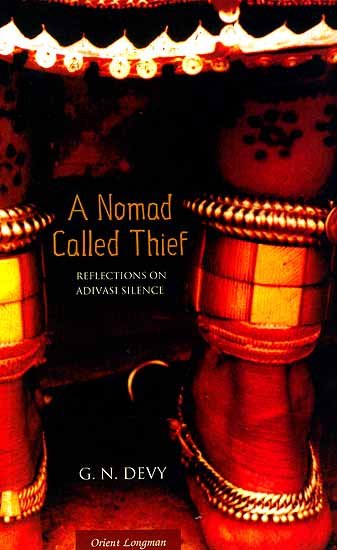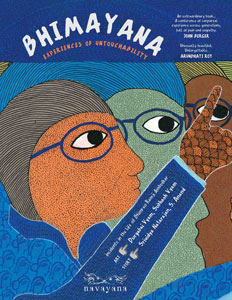Learn more about the Gond community >>
Tip: Bhimayana: Experiences of Untouchability: Critically acclaimed as “a magnificent work of breathtaking art that symbolises the soul-stirring biography of an exceptional leader” and “a must-read for every child and adult in the nation and a must-include in every school’s curriculum”. (Sowmya Sivakumar in The Hindu Literary Review) | Find a library copy on WorldCat.org | Learn more >>
If the book succeeds in making the reader ask what independent India’s worst affliction is, it would go down in history as a document as important as the story of Ambedkar it tells. | Read the full review by Sowmya Sivakumar in The Hindu (Literary Review), May 1, 2011
When I took Bhimayana out from the cover in which it arrived, its beauty stunned me into silence, while my not-yet-three-year-old daughter went into raptures. Losing no time, we settled in a corner, as she sat through 45 pages without budging, getting up only because I had to. Bursting with comments and questions, she was visibly moved when I read out how Ambedkar, as a 10-year-old school boy, was denied water from the handpump because of his ‘mahar’ status. By the end of the book she had made her connection. She half-asked, half-stated, “Amma, dalits are ‘bonded labourers’? (a term she had learnt last month due to my repeated visits to Baran district in Rajasthan where many tribal labourers spoke out about their bondage and indignity at the hands of local zamindars.)
Such is the power of Bhimayana, as I experienced first-hand. And if Bhimayana succeeds in making every child — and adult — ask, reflect and engage in what is ‘independent’ India’s worst affliction, it would go down in history as a document as important as the story of Ambedkar it tells.
To call Bhimayana a ‘book’ would amount to a trivialisation — it is a magnificent work of breathtaking art that symbolises the soul-stirring biography of an exceptional leader. What makes this even more incredible is that traditional Pardhan Gond artists Durgabai Vyam and Subhash Vyam who created this masterpiece, were unaware of Ambedkar until Navayana publisher S. Anand approached them. Unlettered, the artists were read out his story over several sessions, based on Ambedkar’s own autobiographic illustrations titled Waiting for a Visa — accounts that inspired, moved and transformed into free-flowing, magical drawings in a sequential form as we see them. […]
The polemic of Gandhi versus Ambedkar towards the end necessarily brings to our attention that, unlike Gandhi, Ambedkar’s was a far more universal struggle against injustice perpetrated by home-grown oppressors. And the fact that a crime is committed against a dalit every 18 minutes even today shows how his has proved, in many ways, a far more difficult one. Bhimayana drives home that it is high time each one of us owned this struggle. A must-read for every child and adult in the nation and a must-include in every school’s curriculum.
The reviewer is a freelance journalist and activist based in Jaipur.
Source: “Evocative masterpiece” by Sowmya Sivakumar in The Hindu (Literary Review), 1 May 2011
Address : https://www.thehindu.com/todays-paper/tp-features/tp-literaryreview/evocative-masterpiece/article1982381.ece
Date Visited: 29 July 2022
When the Vyams leafed through the likes of Art Spiegelman, Joe Sacco and Marjane Satrapi, they were astonished that the characters were trapped within boxes. “In the beginning it was very difficult to adapt this story into a graphic novel, as the Vyams had never done sequential art,” says Anand. Defying the conventions of the genre they decided to divide their pages into dignas- the traditional design patterns used to adorn the floors and walls of Gond homes. The artists have infused the novel with the imagery that is characteristic of Gond art, arriving at a distinctive aesthetic idiom. “It is a unique style which cannot be replicated anywhere, which is why it is fresh and current,” says Anand. “No one has attempted to do this with the Gond art form.”
As the novel moves between historical events like the Mahad Satyagraha, incidents in Ambedkar’s childhood and contemporary caste issues, Ambedkar is depicted with an orange face and blue spectacles. In this animalistic world peppered with symbolism, dialogue boxes appear in the shape of birds for normal conversation and scorpion tails for spiteful speech, the mikes become surrealist water sprinklers and when the young Ambedkar is denied water the hand pump takes the form of a woman. As the train becomes a snake and the intimidating fort becomes a lion, the boundaries of comic art are surpassed. “In standard western comics, what you see is what you get, as they follow a cinematic imagination. This book is not a realistic work where there is only one layer of meaning,” says Anand. For anyone who thought that comic books are only for kids, these artists are ready to defend their craft.
Source: Unsettled City | the music from the balconies nearby was overlaid by the noise of sporadic acts of violence | Page 5
Address : https://unsettledcity.wordpress.com/page/5/
Date Visited: Sat Nov 30 2013 14:40:25 GMT+0100 (CET)

Reflections on Adivasi Silence and Voice by Ganesh [G.N.] Devy | Publications >>
A call for harnessing the potential of Denotified Tribes, Nomadic and Semi-Nomadic Tribes for national development: “India’s labour force must be liberated from an abhorrent colonial doctrine (‘criminality by birth’)” – Report and Recommendations of the Technical Advisory Group | “Adivasi”, “Tribals” and “Denotified tribes” (classifications in different states) >>
Bhimayana: Experiences of Untouchability (Navayana Publishing, 2011) by Durgabai Vyam, Subhash Vyam, Srividya Natarajan and S. Anand, begins with a discussion at the bus stop about job reservations that establishes the crying need to understand Ambedkar’s life in greater but also more complex detail. The Vyams use the Pardhan Gond tradition of picture-making that relies on intricate linear limning and teeming stipplework (grain, mustard and grass patterns) which allows for an evocative alternation between dense and sparse spaces that hold the text and image. Ingeniously elastic panels created using the digna forms take the narrative forward establishing zones of signification – from Ambedkar’s childhood in Satara to the Chavdar Tank agitation, from the Round Table Conference to his final act of converting to Buddhism. Strewn carefully are news reports on caste atrocities in today’s India, notes on Brahminical texts like the Manusmriti and quotes from Ambedkar’s speeches. The fourth section titled ‘The Art of Bhimayana’, in true Navayana fashion, has the Vyams shedding light on the Pardhan Gond way of imagemaking and discussing their experience of working on the book.
Source: The Rising Graph of the Graphic Book | ART India – The Art News Magazine of India
Address : https://www.artindiamag.com/quarter14_06_12/THE_RISING_GRAPH_of_the_GRA.html
Date Visited: Sat Nov 30 2013 21:17:16 GMT+0100 (CET)
[Bold typeface added above for emphasis]
Find scholarly books, poetry and fiction relating to tribal culture – Indian publishers
List of sites covered by this Google custom search engine
To find children’s and educational books or search Indian periodicals, magazines, web portals and other sources safely, click here >>
Search tips
Combine the name of any particular state, language or region with that of any tribal (Adivasi) community.
Add keywords of special interest (music, poetry, dance just as health, sacred grove and biodiversity); learn about the rights of Scheduled Tribes such as the “Forest Rights Act” (FRA); and the United Nations “Declaration on the Rights of Indigenous Peoples”, “Universal Declaration of Human Rights”, “women’s rights”, or “children’s right to education”.
Ask a question that includes “tribal” or “Adivasi”, for instance: “Adivasi way of life better?” (or “tribal way of life worse?”)
Specify any particular issue or news item (biodiversity, bonded labour and human trafficking, climate change, ecology, economic development, ethnobotany, ethnomedicine, global warming, hunter-gatherers in a particular region or state, prevention of rural poverty, water access).
For official figures include “scheduled tribe ST” along with a union state or region: e.g. “Chhattisgarh ST community”, “Himalayan tribe”, “Scheduled tribe Tamil Nadu census”, “ST Kerala census”, “Particularly Vulnerable Tribal Group Jharkhand”, “PVTG Rajasthan”, “Adivasi ST Kerala”, “Adibasi ST West Bengal” etc.
In case the Google Custom Search window is not displayed here try the following: (1) toggle between “Reader” and regular viewing; (2) in your browser’s Security settings select “Enable JavaScript” | More tips >>
Note: hyperlinks and quotes are meant for fact-checking and information purposes only | Disclaimer >>
Find publications by reputed authors (add “open access” for freely downloadable content)
“In fact, we still do not know to what extent global supply chains are maintained by slavery and child labor. Because of these and other factors, slavery today is more profitable than ever before, and also more woven into the global economy than ever before.” – Siddharth Kara on the persistence of modern slavery| Learn more >>
Human trafficking is a crime. To report in India, call
– Shakti Vahini +91-11-42244224, +91-9582909025 or
– Childline 1098 (national helpline)
Human Rights Commission (posts) | www.nhrc.nic.in (Government of India) >>
Learn more
Adverse inclusion | “Casteism” and its effect on tribal communities
Biodiversity and development – Jharkhand
Bondage | Bonded labour | Human trafficking | Slavery | Zamindari
Chief Justice of India | Imprisonment & rehabilitation
Childhood | Childrens rights: UNICEF India | Safe search
Colonial policies | Freedom Struggle | Independence
Community facilities | NGO | Organizations
Health and nutrition | Recommendations by the Expert Committee
Hul (Santal rebellion 1855-1856) | Tribal freedom fighters
Human Rights Commission (posts) | www.nhrc.nic.in (Government of India)
Information provided by Indian government agencies and other organizations (FAQ)
Nomadic and Semi-Nomadic Tribes | SEED – Government scheme
Shakti Vahini: Striving for Just, Free and Equitable society
Scheduled Tribe (ST) | Denotified Tribe vs. “criminal tribe“
State wise ST list (Scheduled Tribes)
Video | The Expendable People: Adivasis
Video | Hul Sengel: The Spirit of the Santal Revolution (1855) – Jharkhand
Video | Lessons on Human Trafficking – Freedom United
Women | Safe search | President Droupadi Murmu on women’s empowerment
